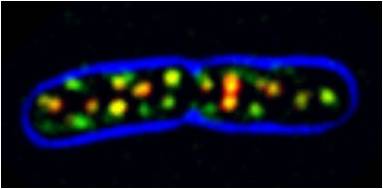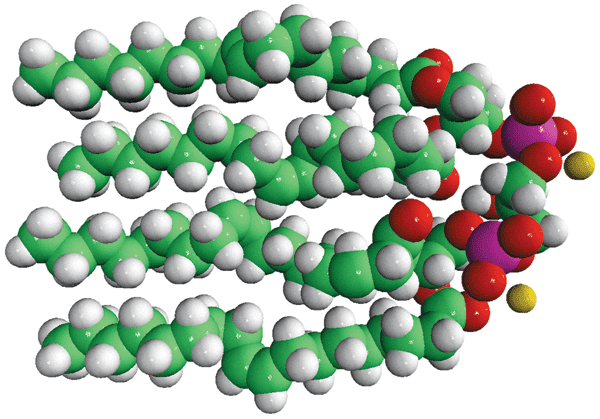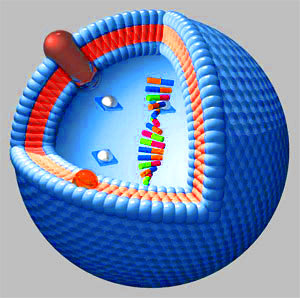Bacterial Lipids
Research in lipids attracted special attention recently. While originating in Life Sciences, current topics of interest are making important connections with nutrition and health issues, and with technological applications of lipids and their derivatives in New Materials Science, for example. A discipline of Lipidomics studies chemical and metabolic lipid transformations in living organisms and offers a comprehensive platform for combining relevant data on lipid changes for further research. Recent studies of fatty acid-related compounds, such as triglycerides, phospholipids, and cholesteryl esters, are adding many significant roles and functions to the canonical properties formerly assigned to them. Lipidomics applied to microorganisms is of special significance as a powerful research tool and also due to its many biotechnology prospects.

Fig. 1: Bacillus subtilis cell
with wall rich in lipids outlined in blue
The microbial lipids' functions are numerous: first of all, bacteria use cell wall lipids to prevent alien things from getting in the cell and for keeping its inner contents within. In this reflection fluorescence microscopy picture (Fig.1) of Bacillus subtilis cell, the area of the cell wall lipids shows such delineation and outlined in blue. Membrane lipid homeostasis is based on diversity of biochemical and genetic regulatory mechanisms and represents a vitally significant fact of bacterial cell physiology [1]. Based on several common building blocks, lipids form an abundance of secondary and tertiary molecular structures, often in cooperation with variety of complex proteins. Thus hierarchical scaffolds form where numerous cascades of metabolic transformations occur.

Fig. 2: Cardiolipin molecule
Hence, in terms of developing new therapeutics that may block pathogen bacterial phospholipid synthesis, or control disorders of lipid metabolism, for example, the studies and application of relevant lipids will be of great interest. Some of the recent substances of interest are:
- Cardiolipin (BMRB entry bmse001105), Fig. 2: an important component of the inner mitochondrial membrane, where it constitutes about 20% of the total lipid composition and where it interacts with a large number of mitochondrial proteins.
- Lipoic acid: the acyl carrier protein of lipid synthesis donates lipoic acid to the pyruvate dehydrogenase complex in mitochondria, as cofactor in lipids synthesis.
- Triacylglycerols (TAGs), known also as human blood lipids. They are connected evolutionary from bacteria physiological mechanism to mammals. The occurrence of TAGs as nutritional reserve compounds is widespread in yeasts, fungi, plants and animals. Accumulation of TAG also seems to be widespread among bacteria belonging to the actinomycetes group. The TAGs metabolic pathways are studied in order to reduce tri-glycerides in blood, when medically necessary. There are some oleaginous bacteria that accumulate TAGs to more than 80% of the cell matter and which have already been used for high cell density cultivation to obtain high concentrations of TAGs in bioreactors, meaning edible oils and fats. (Because The availability of agricultural products depends on weather, climate and possible catastrophes, biotechnological production of valuable lipids may be advantageous.)
- 1,2-dipalmitoyl-sn-glycero-3-phosphoethanolamine-N-(biotinyl) exists to enable covalent or non-covalent conjugations of proteins, peptides or drugs to the liposome surface. Biotin has been used for bilayer stabilization, in temperature/pH sensitive liposomal drug delivery systems, tumor imaging, two-dimensional crystallization on lipid bilayers - and that brings us to applications of lipids in New Materials Science.

Fig. 3: Liposome
This novel area of microbial lipids use is based on their natural ability to compartmentalize and delineate environments, producing nano size vesicles for therapeutic or pharmaceutical purposes. The lipid building blocks in the case normally may have no pronounced pharmacological effects themselves but they serve, in their natural form or derivative one, as vehicles for pharmaceuticals, e.g. in transdermal systems (Fig.3). These include advanced drug delivery systems based on scaffolding dendrimers or liposome structures of specifically tailored microbial lipids. A suitable example would be gadolinium carrying Gd-DTPA-PE hybrid constructs based on phosphatidylethanolamine moieties. They are succesfully applied in Magnetic Resonance Imaging and cancer therapy. Many new hybrid materials for Engineering, such as gold nano shells and quantum dots, were created recently through biomimetic synthetic routes employing nano reactors that mimic bacterial cell walls [2]. A creation of such 3-dimensional structures is often monitored by various NMR spectroscopy tools.
The Metabolomics database at the BMRB contains 1H, 13C, 13CDEPT90, DEPT135, TOCSY, COSY45, HSQC, HMBC and HSQC-TOCSY-ADIA NMR spectral data for compounds related to these lipids researches (such as cardiolipin, bmse001105), presented as the time domain data, the spectra pictures as well as the tables of peak transitions and assigned chemical shifts. The compounds include various fatty acids and their esters, sphingolipids, cholesterol and related substances, isoprenoids, lipid synthesis cofactors etc. Besides direct research, the data are of a real interest for building of the modular suites of exercises for laboratory sessions in Physical Chemistry and Instrumental Analysis, and specifically useful for teaching the 1D and 2D 1H-13C data assignments, providing visual context [3].
1. Alvarez, H. M., Steinbuchel, A., "Triacylglycerols in prokaryotic microorganisms", Appl. Microbiol. Biotechnol. 2002; 60: 367-376. DOI 10.1007/s00253-002-1135-0
2. Mellal, D., Zumbuehl, A., "Exit-strategies - smart ways to release phospholipid vesicle cargo", J. Mater. Chem. B 2014; 2: 247.
3. Gaede, H. C., Stark, R. E., "NMR of a Phospholipid; Modules for Advanced Laboratory Courses", Journal of Chemical Education 2001; 78(9): 1248
The picture of bacteria cell (Fig.1) comes from https://www.mpg.de/4334236/Bacterial_roundabouts; © Roland Wedlich-Söldner / Copyright: MPI for Biochemistry
